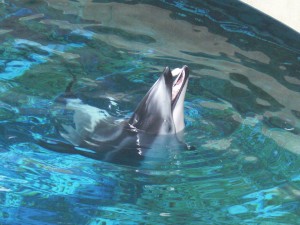5. Dolphin Health in Captivity
Dolphin Health and Welfare in Captive Settings
There are a number of aspects involved in dolphin welfare, some of which seem rather obvious while others are harder to judge. Welfare in a captive animal goes beyond simple measures of health or mortality, although these are certainly important features of an animal’s life, captive or wild. Health, stress, behaviour, boredom, and the “unnaturalness” of a captive setting are all important factors to look at when thinking about the welfare of a zoo or aquarium animal.
Health and Mortality
One of the major factors that public display facilities use when arguing that captive dolphins experience good welfare is the presence of veterinary care in the captive setting. Animals in the wild don’t have access to veterinary care, and so illnesses and injuries are often fatal events when they occur in the wild, whereas a captive animal has a higher chance of survival due to medicines and treatments from veterinarians combined with the absence of predators (Grimm 2011). It is difficult to know for certain how to apply mortality rates of captive versus wild dolphins in the context of animal welfare. Groups that oppose keeping dolphins in captivity cite statistics that say dolphins in captivity have shorter lifespans than those in the wild (Rose et al. 2009). Scientists that support keeping captive dolphins refer to statistics that show no difference in mortality rates between wild populations and captive ones (Grimm 2011). A study from 1995 put bottlenose dolphin annual survival rates at 95% in captivity, but this was based on adults (Small and DeMaster 1995). It is hard to say which sets of data are more accurate, and each population is dealing with different sets of challenges. The mortality rate for wild dolphins can be very high, especially amongst newborns, and large numbers of wild dolphins have scars from attacks from sharks and encounters with boats or fishing nets (Grimm 2011). When considering survival rates, the rate of mortality has to be considered both for young animals where sudden death is most common, and average lifespans for adults that make it past the first years. Opposition groups also like to cite how many dolphins have died at a given facility, without giving details on how long the animals were there, what their condition was when they were brought in or how they died. Given a long enough period of time, all individual captive animals will die, but so will wild ones.
Stress and Boredom in Captive Settings
Animal welfare involves much more than just physical health. The high intelligence level of dolphins means that they require mental stimulation in order to prevent boredom (Grimm 2011). This is one of the biggest arguments used by the opponents of dolphin captivity, that the relatively small size of dolphin pools and lack of stimulation that results in bored, frustrated dolphins (Rose et al 2009). Facilities and scientists that support dolphin captivity cite trainer/animal interaction, social interactions between animals, interaction with the public, and environmental enrichment programs as factors that mediate boredom in captive dolphins (Grimm 2011). There has been a lot of study on dolphin behaviour in captivity. Dolphin behaviour in the wild is focused to a large extent on finding food, and this activity is minimized or non existant in captive dolphins, replaced by interval feedings from trainers (Galhardo et al. 1996). Because the dolphins are not spending a large portion of their days looking for food, other activities such as resting, playing, and socializing take up proportionally more of their time than they would in the wild (Galhardo et al. 1996). It is tempting to say that a dolphin that spends most of its time resting in ‘bored’, but it is hard to know for sure what a dolphin would consider boring. Stereotyped behaviors such as performing the same action with a toy or piece of food over and over again, rubbing on walls or structures, and swimming in repetitive loops can occur in captive dolphins (Grimm et al. 2009).

Helen (Vancouver Aquarium) doing food toss. Helen is known to save a piece of food from her feedings and will spend a long time tossing it up in the air and catching it until it becomes so small she can't do it any more
Stress in dolphins is also difficult to establish, although there are some means. Stress causes a response in animals that increases the levels of cortisol in the blood, and prolonged stress can have detrimental effects on an animal’s health. One mechanism of measuring cortisol levels is by taking blood, but with animals this can cause additional stress during the blood taking procedure. There is another procedure that can be used to monitor cortisol levels, and this is through sampling of salivary cortisol (Pedernera-Romano et al. 2006). Salivary cortisol can be measured quickly and non-invasively, and can be combined with behavioural analysis to monitor ongoing stress levels in captive dolphins (Pedernera-Romano et al. 2006).